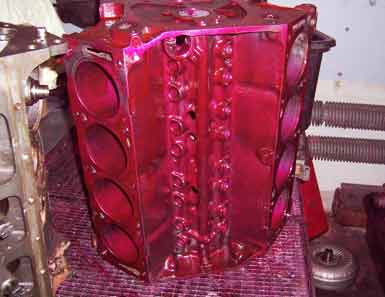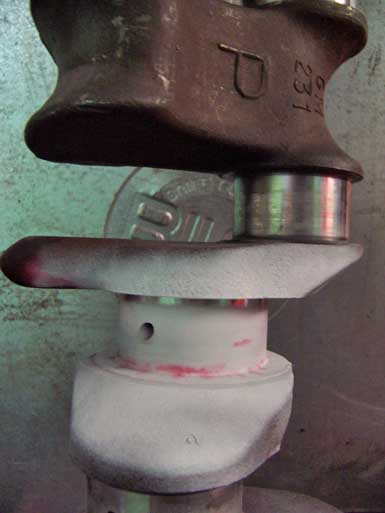Cast inspection, size determination
Once thoroughly cleaned all components will again be subject to a more elaborate inspection for cracks, stripped threads, straightness and other cast related damages which would disqualify them from our rebuilding philosophy.
Engine blocks are dye tested. First a red dye is applied to all cylinders, the external surfaces and the crankshaft alley. After 30 minutes in which the dye would be absorbed from any cracks the blocks again get cleaned before a white “developer” is applied to the exact same areas. Any crack would show up in red on the now white surface, the developer basically causes any absorbed red dye to become visible on the surface.
The same technique is used to detect cracks on crankshafts.
Cylinder heads will be filled with boiling water and closed with a matching pressure plate before applied air pressure will detect cracks and other cast related damages.


Before the actual rebuilding process begins, all future sizes will be determined by accurate measuring and comparison to the stock sizes. Stages of wear like out-of-round cylinders are determined with precise inside dial gauge calipers in fractions of 0,01 millimeters. Crankshaft journals are also measured with precise micrometers in fractions of 0,01 millimeters.
Crankshaft and camshaft alleys are measured for straightness, bearing housings are measured for roundness also using precise inside dial gauge calipers in fractions of 0,01 millimeters.
Due to the fact that line-boring reduces the distance between crankshaft and camshaft leading into possible timing chain tension issues, we only repair single main bearing housings. Blocks that require a full align boring are scraped.
Blocks are only being resurfaced if absolutely necessary to avoid sealing problems in the intake manifold areas due to the “v”-angle becoming wider with each material removal.
Overall we are determined to use the smallest possible over/undersize during remanufacturing.